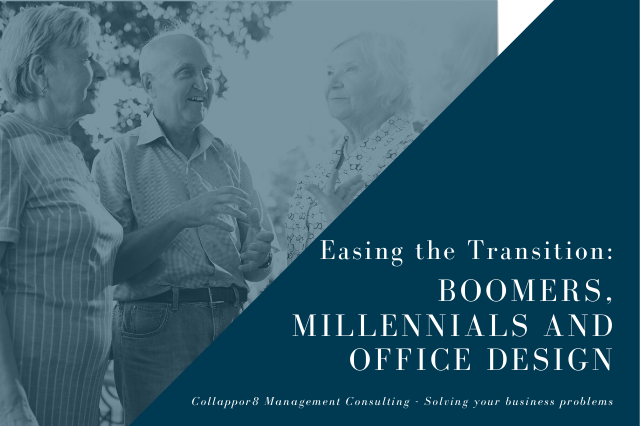- January 15, 2020
- Posted by: Sharon Lam
- Categories: Business Continuity, Culture, Management Consulting, People, Planning, Work Space

Trying to cater to the needs of three different generations in the workplace is a common, neglected issue in many offices. With the workforce on the cusp of being overturned by millennials taking up the majority of the workforce over the Boomers (projections from 2016 state that by 2019 Millennials will reach 73 million while Boomers decline to 72 million), millennial preferences have become the driving force of office design and culture for many businesses.
 Regrettably, that can be an unpleasant culture shock for the older generations who have been loyal to the company for years on end. They’ve been the backbone and logic for their businesses for decades and subsequently had offices designed for their needs and preferences. Years of habits, traditions and expectations being shifted in the office can cause unwelcome disruption to your loyal Boomer employees.
Regrettably, that can be an unpleasant culture shock for the older generations who have been loyal to the company for years on end. They’ve been the backbone and logic for their businesses for decades and subsequently had offices designed for their needs and preferences. Years of habits, traditions and expectations being shifted in the office can cause unwelcome disruption to your loyal Boomer employees.
Although having an entirely age-neutral workspace is nigh impossible, we must acknowledge the growing need to know how to create a diverse workplace that suits a variety of work styles, values, beliefs and generations.
But how can this be achieved with the drastically different philosophies of the Boomers and the Millennials?
Boomers and Millennials: Competing Interests in the Workplace
The philosophical differences between Baby Boomers and Millennials are quite substantial, which further impact their choices for what things and qualities their employees seek out and value in their offices.
There are some values that hold strong across whole generations.
For example, expectations on work-life balance. While Millennials see work as an integrated part of life and therefore value socialising on the jobs, an engaging workplace, and fulfilling work, Boomers instead separate the concepts of ‘work’ and ‘life’ and seek a balance between the two. Therefore, Boomers have much less expectation on the quality of socialising and the workplace, instead, valuing friendly competition and private work areas to productively finish their jobs.
In fact, Baby Boomers value ‘an engaging workplace’ lowest on their needs, while Millennials ranked this on an entirely opposite scale. Similarly, Millennials don’t place having high-quality meeting rooms as a must in the office, but Boomer’s value spaces like this greatly.
As seen in recent trends in office planning with the Millennial revival of the open-plan office, the Boomer’s desire for private and quiet workspaces have instead become the traditional way of doing things. Open office layouts designed to encourage moving, socialising, and collaboration without regards for private offices or authoritarian and status symbols.
Having grown up in an era where private offices are a symbol of their hard work, status and success, this can particularly affect Boomers the most.
Finding the Balance: Open-plan Office Design doesn’t mean lack of privacy
Millennials have given rise to the open office, and open offices are designed for easy communication and access to any individual working in the office, allowing quick and reactive transitions from anything a project needs, from solo to team to brainstorming work.
However, the limitations of open-plan offices are well-known even to the Millennials who thrive in a sociable workplace – many times, open offices can be loud and distracting, while the lack of privacy can invite an overly self-conscious work culture as people fail to relax in their workspace in fear of social judgment.
Therefore, the best office designs cater to all work styles and needs by providing a variety of breakout spaces, conference rooms, private cubicles or pods, huddle rooms and such. That way, the flexibility can cater to any of your worker’s needs, such as a Boomer’s need for privacy to effectively work.
Mid-sized conference rooms are also a good compromise from large formal conference rooms. Fulfilling the desire for Boomers to have formal spaces to meet and organise ideas, they can also be convenient for managers in an open office to discuss sensitive matters in privacy. Having moveable private spaces like pods or set private booths can also give your workers a chance to choose the environments they work best.
 Baby Boomers also appreciate having a clearly defined authorities and business structure. This doesn’t need to be abandoned in open offices. In fact, clearly defined policies and procedures as to who to turn to in certain situations help to avoid confusion in the office. Spending time to clearly communicate who is in charge of can help your business operations run smoother and smooth tensions before their rise.
Baby Boomers also appreciate having a clearly defined authorities and business structure. This doesn’t need to be abandoned in open offices. In fact, clearly defined policies and procedures as to who to turn to in certain situations help to avoid confusion in the office. Spending time to clearly communicate who is in charge of can help your business operations run smoother and smooth tensions before their rise.
Without private offices, you can also fulfil a Boomer’s need to feel validated in their authority and work by introducing awards like ‘Employee of the Year’ and other friendly competitive bonuses or awards. Boomers appreciate the competition to motivate them to work harder, and keeps them happy and appreciated in the business.
If you are looking for more tips to keep different generations happy, or have any questions on what good office design can do for you, consider Collappor8 Business Interiors or call us on (02) 8774 2682.
